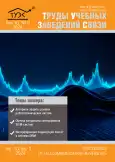Кодовое разделение на основе двойного расширения спектра сигнала
- Авторы: Кукунин Д.С.1
-
Учреждения:
- Санкт-Петербургский государственный университет телекоммуникаций им. проф. М. А. Бонч-Бруевича
- Выпуск: Том 10, № 3 (2024)
- Страницы: 45-58
- Раздел: ЭЛЕКТРОНИКА, ФОТОНИКА, ПРИБОРОСТРОЕНИЕ И СВЯЗЬ
- URL: https://journals.rcsi.science/1813-324X/article/view/259511
- EDN: https://elibrary.ru/KQSXLR
- ID: 259511
Цитировать
Полный текст
Аннотация
Об авторах
Д. С. Кукунин
Санкт-Петербургский государственный университет телекоммуникаций им. проф. М. А. Бонч-Бруевича
Email: kukunin.ds@sut.ru
ORCID iD: 0000-0002-2674-5217
SPIN-код: 5276-1211
Список литературы
- Бабков В.Ю., Никитин А.Н., Осенний К.Н., Сиверс М.А. Системы связи с кодовым разделением каналов. СПб.: TPMADA, 2003. 239 с.
- Бобровский В.И. Многопользовательское детектирование. Ульяновск: Вектор-С, 2007. 346 с.
- Бобровский В.И. Фрактальные алгоритмы многопользовательского детектирования «плотных» ансамблей сигналов // Техника средств связи. 2019. № 4(148). С. 15–28. EDN:YFHTZY
- Шахнович И.В. Современные технологии беспроводной связи. М.: Техносфера, 2006. 288 с. EDN:QMPRPT
- Hajar A., Hamamreh J.M., Abewa M., Belallou Y. A Spectrally Efficient OFDM-Based Modulation Scheme for Future Wireless Systems // Proceedings of Scientific Meeting on Electrical-Electronics & Biomedical Engineering and Computer Science (EBBT, Istanbul, Turkey, 24‒26 April 2019). IEEE, 2019. doi: 10.1109/EBBT.2019.8742049
- Du Y., Liu J., Chen Y. Performance Analysis of Nonlinear SFBC OFDM Systems Over TWDP Fading Channel // IEEE Access. 2019. Vol. 7. PP. 101981‒101991. doi: 10.1109/ACCESS.2019.2927753
- Кукунин Д.С., Когновицкий О.С., Березкин А.А., Киричек Р.В. Перспективы использования рекуррентных последовательностей в современной телекоммуникационной среде. СПб.: СПбГУТ, 2023. 289 с.
- Когновицкий О.С. Широкополосные сигналы данных с расширением спектра прямой последовательностью и их характеристика // Труды учебных заведений связи. 2016. Т. 2. № 1. С. 82‒89. EDN:XCGQHP
- Khudhair A.Y., Abd Khalid R.A. Reduction of the Noise Effect to Detect the DSSS Signal using the Artificial Neural Network // Proceedings of the 1st Babylon International Conference on Information Technology and Science (BICITS, Babil, Iraq, 28-29 April 2021). IEEE, 2021. PP. 185‒188. doi: 10.1109/BICITS51482.2021.9509880
- Visan D.A., Jurian M., Lita I., Ionescu L.M., Mazare A.G. Direct Sequence Spread Spectrum Communication Module for Efficient Wireless Sensor Networks // Proceedings of the 11th International Conference on Electronics Computers and Artificial Intelligence (ECAI, Pitesti, Romania, 27‒29 June 2019). IEEE, 2019. doi: 10.1109/ECAI46879.2019.9041979
- Dmitriyev E.M., Rogozhnikov E.V., Movchan A.K., Mukhamadiev S.M., Krukov Y.V., Duplishcheva N.V. Spread spectrum technology research and its application in power line communication systems // T-Comm. 2020. Vol. 14. Iss. 10. PP. 45‒52. doi: 10.36724/2072-8735-2020-14-10-45-52. EDN:VZDBDQ
- Qiu Z., Peng H., Li T. A Blind Despreading and Demodulation Method for QPSK-DSSS Signal With Unknown Carrier Offset Based on Matrix Subspace Analysis // IEEE Access. 2019. Vol. 7. PP. 125700‒125710. doi: 10.1109/ACCESS.2019.2938785
- Варакин Л.Е. Системы связи с шумоподобными сигналами. М.: Радио и связь, 1985. 384 c.
- Деев В.В. Методы модуляции и кодирования в современных системах связи. СПб.: Наука, 2007. 268 с.
- Прокис Дж. Цифровая связь. Пер. с англ. М.: Радио и связь, 2000. 797 с.
- Никитин Г.И. Применение функций Уолша в сотовых системах связи с кодовым разделением каналов: учебное пособие. СПб.: ГУАП, 2003. 86 с.
- Кукунин Д.С., Березкин А.А., Киричек Р.В. Многослойные ортогональные структуры на основе последовательностей максимальной длины // Инфокоммуникационные технологии, 2022. Т. 20. № 2(78). С. 42‒50. doi: 10.18469/ikt.2022.20.2.05. EDN:DOLLWE
- Kukunin D., Berezkin A., Kirichek R. Asynchronous Address System Using Code Division Based on Maximum Length Sequences // Proceedings of International Conference on Information, Control, and Communication Technologies (ICCT, Astrakhan, Russian Federation, 03‒07 October 2022). IEEE, 2022. doi: 10.1109/ICCT56057.2022.9976772
- Кукунин Д.С., Березкин А.А., Киричек Р.В., Елисеева К.А. Асинхронная передача данных с использованием многослойных ортогональных структур в системах с кодовым разделением каналов // Электросвязь. 2023. № 1. С. 26‒35. doi: 10.34832/ELSV2023.38.1.003. EDN:HNTXND
- Когновицкий О.С. Двойственный базис и его применение в телекоммуникациях. СПб.: Линк, 2009.
Дополнительные файлы






